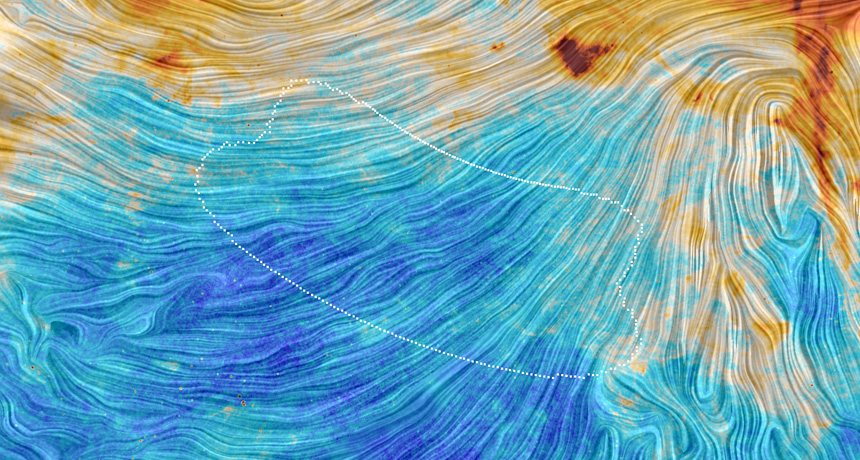Dust erases evidence of primordial gravity waves
Ripples in the fabric of space may exist, but oops — no one has found them yet

The Planck space telescope analyzed the same patch of sky (within white dots) as BICEP2 in a search for ripples in the fabric of space. Yellow and red patches highlight areas with the most galactic dust, which initially tricked scientists.
PLANCK/ESA COLLABORATION. ACKNOWLEDGMENT: M.-A. MIVILLE-DESCHÊNES, CNRS – INSTITUT D’ASTROPHYSIQUE SPATIALE, UNIVERSITÉ PARIS-XI, ORSAY, FRANCE
By Andrew Grant
Dust just cleared up a recent mistake by astronomers. Last year, they had announced finding the earliest echoes of the Big Bang. It now turns out that they hadn’t.
Those researchers stunned the world, a year ago, when they said they had evidence that the universe inflated in a flash just after the Big Bang, 13.8 billion years ago. But that initial report was wrong, those same scientists now concede. Instead of ripples in the fabric of space, they now say they simply spied the glint of dust swirling through the Milky Way, our galaxy.
Many scientists believe the universe exploded outward faster than the speed of light during the first trillionth of a trillionth of a trillionth of a second after the Big Bang. It soon stretched out farther than any telescope can see. Astronomers refer to this theory as inflation.
Inflation is important. It helps answer some questions raised by the Big Bang. It explains, for instance, why the universe looks the same in every direction. It also explains why the universe is smooth. Still, scientists have lacked solid evidence for inflation.
Last year, one research group announced it had found that evidence. Those same researchers now report they no longer trust their initial claim. It appears, they explain, galactic dust rich in carbon and silicon confused them.
That dust can create distinctive patterns of light. And those patterns look like the patterns that would be made by ripples of gravitational waves that inflation would have sent through space.
The European Space Agency announced the new analysis on January 30. It was careful to point out that this doesn’t mean the theory of inflation is wrong. Nor does it mean that gravitational waves caused by inflation don’t exist.
“It’s perfectly plausible that there are primordial gravitational waves,” says Raphael Flauger. “But experiments right now are just not accurate enough to determine this.” Flauger works at Carnegie Mellon University in Pittsburgh, Penn. As a cosmologist there, he studies the origin and evolution of the universe.
For their original search, scientists used a telescope at the South Pole. It’s called BICEP2 (which is short for the Background Imaging of Cosmological Extragalactic Polarization). Last March, the experts claimed to have detected swirling patterns in waves of the oldest light in the universe. These light waves are known as the cosmic microwave background. The rapid stretching of the fabric of space during inflation imprinted those patterns, the researchers said.
Unfortunately, our Milky Way had played a cruel trick. Shards of carbon and silicon in our galaxy emit light imprinted with a swirl. That pattern looks just like the signature of those early gravitational waves. The team insisted they had accounted for the presence of this dust. Still, in the weeks and months following their announcement, other researchers published analyses that brought doubt on the discovery.
So the first team took another look. It worked with scientists connected with the European Space Agency’s Planck space telescope and with another telescope at the South Pole called the Keck Array.
Joanna Dunkley is an astrophysicist at the University of Oxford. She is also coauthor of the new analysis. She says the BICEP2 researchers didn’t initially appreciate the uncertainty of dust’s contribution to their measurement. Once the contribution from dust is removed, she says, the remaining signal is too small to be considered a discovery.
Power Words
(for more about Power Words, click here)
astronomy The area of science that deals with celestial objects, space and the physical universe as a whole. People who work in this field are called astronomers.
astrophysics An area of astronomy that deals with understanding the physical nature of stars and other objects in space.
Big Bang The rapid expansion of dense matter that, according to current theory, marked the origin of the universe. It is supported by physics’ current understanding of the composition and structure of the universe.
cosmic microwave background radiation Remnant energy (in the form of heat) from the Big Bang and that should exist throughout the universe. It is estimated to be about 2.725 degrees above absolute zero.
cosmology The science of the origin and development of the cosmos, or universe.
galaxy A massive group of stars bound together by gravity. Galaxies, which each typically include between 10 million and 100 trillion stars, also include clouds of gas, dust and the remnants of exploded stars.
gravity The force that attracts anything with mass, or bulk, toward any other thing with mass. The more mass that something has, the greater its gravity.
gravity waves Ripples in the fabric of space that should begun traveling through the universe at its explosive start: the Big Bang.
inflation theory (in astronomy) A theory that proposes a period of extremely rapid expansion of the universe during its first few moments.
Milky Way The galaxy in which Earth’s solar system resides.
primordial An adjective that refers to something that goes back to the beginning of time or to the earliest existence of something that is very old.







